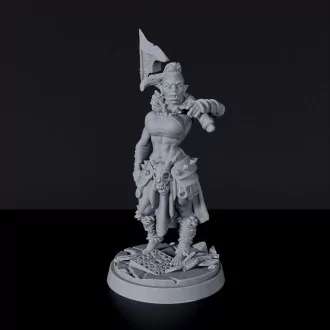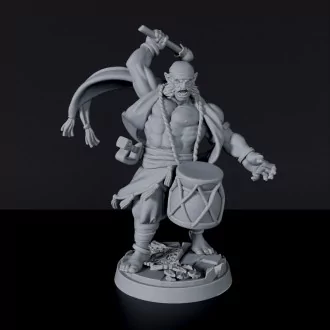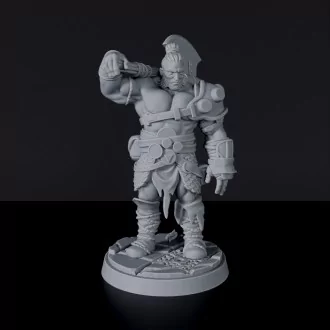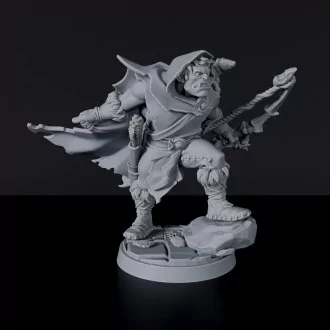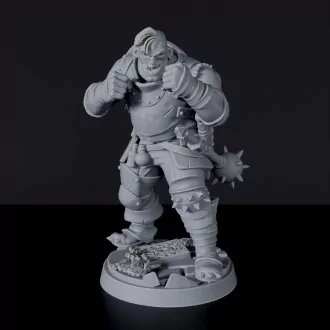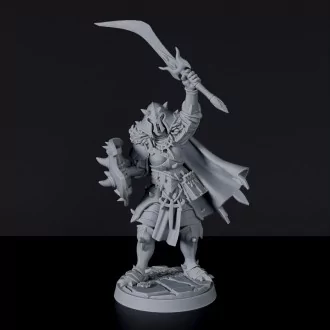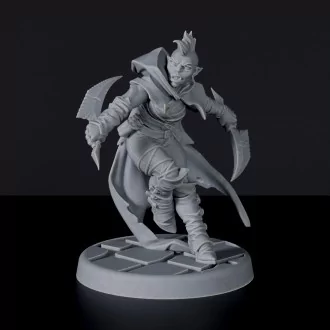Half-Orcs
A half orc-miniature collection created by Titan Forge. Get the half-orc druid, half-orc rogue, half-orc bard, half-orc fighter, and half-orc barbarian miniatures that are ready for painting and for tabletop. Enhance your RPG experience!
bards
Half-Orc Male Bard
barbarians
Half-Orc Male Barbarian
half-orcs
Half-Orc Male Ranger
half-orcs
Half-Orc Male Fighter
paladins
Half-Orc Female Paladin
half-orcs
Half-Orc Female Paladin
half-orcs
Half-Orc Female Paladin
half-orcs
Half-Orc Female Rogue
half-orcs
Half-Orc Female Rogue
half-orcs
Half-Orc Female Rogue
What are the attributes of a typical PRG half-orc mini?
Half-orc miniatures represent characters that are the offspring of orcs and humans. Typically, they exhibit a blend of physical and cultural traits from both races. A half-orc model will have a physique that is larger and more muscular than humans, with a robust build inherited from the orcs. Broad shoulders, powerful limbs, and a sturdy frame are often found in half-orc miniatures and female half-orcs models in dnd. Their faces are characteristic due to sloping foreheads and heavy brows, with protruding tusks, pointed ears, and strong jawlines. Half-orc models are typically painted in a skin tone that ranges from green through gray to brown. To emphasize their mixed heritage, half-orc often include details like tribal tattoos, fur and leather clothes, and feral accessories. A half-orc miniature pose should convey their personality. This could range from a stoic defensive stance of a half-orc fighter miniature to a more aggressive, weapon-wielding pose of a half-orc barbarian model. Titan Forge is known for heroic poses that really bring out the miniature’s character and we guarantee that you will find a great model for your half-orc character in our offer.
What are the common weapons, equipment, armor, and clothing of half orc miniatures?
A variety of garments and accessories can be found on half-orc models. They are known for their strength and combat prowess, so their miniatures often wield heavy and brutal weapons. This includes half-orc miniatures with axes (one-handed and double-handed axes), swords (longswords, greatswords, falchions), hammers (warhammers and mauls), bows (longbows and shortbows), polearms (glaives, halberds, or spears). maces, and flails. The equipment carried by half-orc miniatures will depend on the half-orc class, role, and needs, but some common equipment includes shields (round, heater, or tower), backpacks and pouches for carrying supplies, ropes, grappling hooks, or climbing gear, torches, lanterns, and light sources. Half-orc figures wear various types of armor which can range from leather armor and hide armor for light protection; chain mail, scale mail, or breastplates for medium protection; plate armor or splint mail for heavy protection; or they can go unarmored or lightly armored fo half-orc monk minis, half-orc barbarians models, and half-orc spellcaster figures. The clothing worn by half-orc miniatures can range from simple and functional to elaborate and ornate.
What RPG class should I choose for my half-orc character?
A typical go-to for half-orcs is the barbarian class thanks to their natural strength and toughness. They excel in dealing damage and soaking up hits due to their rage ability, which grants them resistance to physical wounds and bonus damage to melee attacks. Their menacing trait can also synergize well with the intimidating presence ability of the barbarian. However, half-orcs are quite adaptable and can shine in many variations. As a fighter, a half-orc miniature can make the most of their power and combat prowess. Specialization in various weapons and armor types combined with relentless endurance traits can provide extra survivability in battle. Half-orc paladin miniatures can also be quite popular, as orcs can utilize their strength by wielding heavy weapons and wearing heavy armor while channeling divine power to smite their foes and protect their allies. They also provide some interesting roleplaying opportunities. Although this race may not be the most dexterous, half-orc ranger models and half-orc rogue minis can still be successful, especially with a focus on melee combat or two-handed weapons. Their darkvision can be a valuable asset during night-time scouting or exploration. Half-orc cleric models and half-orc warlock miniatures are also popular, despite half-orc not having an inherent bonus to their spellcasting abilities. If you are willing to invest in them, you will get some interesting character concepts.
What are the common subtypes of fantasy half-orc models?
In most traditional fantasy settings, half-orc minis are not further divided into sub-races like elves and dwarves. However, in homebrew campaigns or an alternative setting, you may encounter variations of half-orc models based on the different orcish tribes or human ethnicities they come from. This can mean that by adjusting the painting style and character background, you may create a concept for mountain half-orcs descended from orcs living in mountain regions or humans accustomed to high altitudes. with increased climbing speed and resistance to cold. Or nomadic half-orc models that come from a wandering tribe and are more skilled to survive in various environments, possess increased land speed, and tracking abilities. Forest half-orc miniatures have improved camouflage and natural affinity with animals, arctic half-orc models inhabit frigid, icy regions and have adapted to subzero temperatures with traits like resistance to cold damage. These are just a few examples. Half-orc characters can combine many diverse abilities and backgrounds of fantasy realms.
